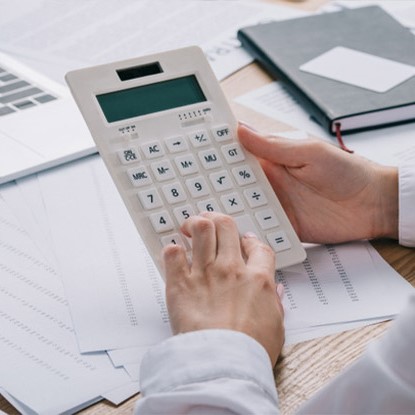Invoice Automation: Streamlining Accounts Payable with Automated Invoicing Solutions
Learn how invoice automation revolutionizes accounts payable. Explore its benefits, underlying technology, and cross-industry applications.

Learn how invoice automation revolutionizes accounts payable. Explore its benefits, underlying technology, and cross-industry applications.

Have you ever felt buried under a mountain of invoices? Do you spend countless hours manually entering data, chasing approvals, and correcting errors? If so, you’re not alone. Traditional paper-based invoicing is a time-consuming and error-prone process. But there’s a solution!
Invoice automation streamlines the entire invoicing process, allowing you to focus on what truly matters – growing your business. In this article, we’ll explore the many benefits of invoice automation and how it can transform your financial operations. You will learn:

Discover how InvoiceAction can transform your accounts payable department by automating data capture, validation, and approval workflows. Eliminate manual errors and speed up your payment cycles with our cutting-edge solution.
Invoice automation is the use of technology to streamline and automate the entire invoice processing workflow, from receiving invoices to making payments. Traditionally, this process involves a lot of manual work, like data entry, chasing approvals, and correcting errors.
Invoice automation solves these pain points by leveraging software and artificial intelligence (AI) to handle these tasks more efficiently and accurately.
Here’s a breakdown of the invoice automation process:
CONTINUE READING: Manual Invoice Processing vs Automated Invoice Processing
Invoice automation frees up your team’s time from tedious tasks, allowing them to focus on more strategic activities. It also reduces human errors associated with manual data entry.
Most importantly, invoice automation streamlines the approval process and ensures vendors are paid on time. Overall, it provides real-time insights into your accounts payable processes. As a result, invoice automation saves money on printing, postage, and labor associated with manual invoice processing.
Overall, invoice automation is a powerful tool that can significantly improve your accounts payable operations, boost efficiency, and free up valuable resources to grow your business.
Revolutionize Document Management with docAlpha!
Leverage docAlpha’s powerful document automation capabilities to seamlessly extract and organize invoice data. Enhance accuracy, reduce processing time, and integrate effortlessly with your existing ERP system.
Book a demo now
Invoice automation relies on a powerful combination of technologies to transform the way you handle bills.
This is the workhorse of data extraction. OCR technology acts like a digital eye, scanning and interpreting text from invoices (even scanned PDFs) and converting it into machine-readable data.
ML algorithms go beyond simple text recognition. They are trained on vast amounts of invoice data, allowing them to identify patterns and nuances in invoice layouts from different vendors. This enables them to extract data with high accuracy, even for invoices with unconventional formats.
AI takes invoice automation a step further by applying reasoning and decision-making capabilities. AI can handle exceptions, like identifying missing information or potential duplicates, and flag them for human review. Some advanced AI solutions can even learn from these exceptions and continuously improve their data extraction accuracy over time.
This technology automates the movement of invoices through the approval process. Invoices are routed electronically to designated personnel based on pre-defined rules (e.g., sending invoices above a certain amount to a manager for approval). This eliminates the need for manual routing and chasing down signatures.
READ MORE: The Human Touch in Automated Invoice Processing
Cloud-based invoice automation solutions offer several advantages. They are accessible from anywhere with an internet connection, eliminate the need for expensive software installations, and ensure data security through robust cloud security measures.
The interplay of these technologies empowers invoice automation software to:
By leveraging this technological foundation, invoice automation solutions transform a paper-based burden into a streamlined and efficient digital process.
Optimize Your Payments with ArtsylPay!
Simplify and secure your payment processes with ArtsylPay. Automate and streamline payments, ensuring timely and accurate transactions while improving vendor relationships and
cash flow management.
Book a demo now
Invoice automation isn’t just for big businesses or specific sectors. It offers benefits that can be applied across a wide range of industries. Here’s a glimpse into how different industries leverage invoice automation.
Manufacturers often deal with a high volume of invoices from various suppliers for raw materials, equipment, and other expenses. Invoice automation streamlines this process by efficiently capturing data from complex invoices (sometimes with multiple line items) and ensuring timely payments to vendors, keeping production lines running smoothly.
Retailers juggle invoices from distributors, logistics companies, and marketing agencies. Automating invoice processing eliminates manual data entry for large purchase orders and automates tasks like calculating discounts and handling returns. This frees up retail staff to focus on customer service and sales.
Construction companies manage complex projects with numerous subcontractors and material suppliers. Invoice automation ensures accurate tracking of project costs by capturing data from invoices for materials, labor, and equipment rentals. This improves project budgeting and cost control.
Hospitals and clinics deal with a high volume of invoices from pharmaceutical companies, medical equipment suppliers, and other vendors. Automating invoice processing reduces errors in medical billing and ensures timely payments to keep vital supplies flowing.
Consulting firms, accounting firms, and other professional service providers often deal with project-based invoices. Invoice automation helps them streamline the process of sending invoices to clients, capturing billable hours accurately, and tracking payments, improving cash flow.
Non-profits rely on funding from grants and donations. Invoice automation helps them efficiently manage invoices for operational expenses and track project-related costs, ensuring transparency and accountability to donors.
Beyond these specific industries, invoice automation benefits any business that receives and pays invoices regularly. It reduces administrative burdens, improves financial visibility, and frees up valuable resources to focus on core business activities.
Additionally, invoice automation solutions can be customized to cater to the specific needs of each industry. For example, some solutions might offer features like integration with project management software for construction companies or healthcare-specific coding for medical billing.
Overall, invoice automation transcends industry boundaries, offering a powerful tool to streamline accounts payable processes and boost efficiency for businesses of all sizes and sectors.
Achieve End-to-End Invoice Automation!
Combine the strengths of InvoiceAction and ArtsylPay for comprehensive invoice automation.
From data capture to payment processing, automate every step to enhance efficiency and accuracy in your financial operations.
Book a demo now
Invoice processing refers to the entire cycle of handling invoices, from their receipt to their eventual payment. This process includes capturing invoice data, validating the information, approving the invoice, and recording the transaction in the financial system.
Automated invoice processing uses software to streamline these steps, reducing manual intervention and errors. Automation tools often incorporate features such as optical character recognition (OCR) to digitize paper invoices and integrate with accounting systems for seamless data transfer.
DISCOVER MORE: How to Build an Automated Invoice Processing Workflow
Optical character recognition (OCR) is a technology used to convert different types of documents, such as scanned paper documents, PDFs, or images taken by a digital camera, into editable and searchable data.
In the context of invoice automation, OCR extracts key information from invoices, such as vendor details, invoice numbers, dates, and amounts, and converts this information into a digital format. This digitization process significantly reduces the need for manual data entry, thereby speeding up the invoice processing cycle and minimizing human error.
Modern OCR systems are often enhanced with machine learning algorithms to improve accuracy and adapt to different invoice formats over time. By integrating OCR into invoice automation systems, businesses can achieve higher levels of efficiency and data integrity.
Electronic invoicing (e-Invoicing) involves the exchange of invoice information between a supplier and a buyer in an electronic format. Unlike traditional paper-based invoicing, e-invoicing eliminates the need for physical documents and manual handling, enabling faster and more secure processing.
eInvoicing process often utilizes standardized formats, such as XML or EDI, to ensure compatibility and ease of integration across different systems. E-invoicing reduces the risk of lost or misplaced invoices, minimizes processing errors, and facilitates quicker payments.
Additionally, it provides better transparency and traceability, allowing both parties to monitor the invoice status in real-time.

Contact Us for an in-depth
product tour!
An automated approval workflow is a predefined process within invoice automation systems that routes invoices to the appropriate personnel for review and approval. This workflow is designed to mirror an organization’s approval hierarchy and business rules, ensuring that invoices are reviewed by the correct individuals based on criteria such as invoice amount, department, or project.
Automation of the approval workflow eliminates bottlenecks caused by manual approvals, accelerates the overall processing time, and ensures compliance with internal policies. Notifications and reminders can be set up to alert approvers of pending tasks, further enhancing efficiency. By streamlining the approval process, businesses can reduce delays and improve their cash flow management.
Three-way matching is a crucial verification process in invoice automation that involves cross-referencing three key documents: the purchase order (PO), the goods receipt note (GRN), and the invoice. This process ensures that the details on the invoice match what was ordered and received, such as quantities, prices, and terms.
Automation tools perform three-way matching by comparing data from the relevant documents electronically and flagging any discrepancies for review. This automated check helps prevent overpayments, duplicate payments, and fraud. Implementing three-way matching enhances the accuracy of financial records and strengthens internal controls, contributing to overall financial integrity.
FIND OUT MORE: Invoice Processing in Accounts Payable Automation
Invoice exception handling refers to the process of managing invoices that deviate from standard processing due to discrepancies or errors, such as mismatched totals, missing information, or unapproved charges.
Automated systems can detect these exceptions quickly by applying predefined rules and criteria. Once an exception is identified, the system typically routes the invoice to the appropriate personnel for resolution, often with suggested actions based on the nature of the discrepancy.
This invoice automation reduces the time and effort required to address issues, ensures that exceptions are handled consistently, and minimizes the risk of payment delays. Effective exception handling helps maintain the efficiency of the invoice processing workflow and ensures timely and accurate payments.
A supplier portal is an online platform that allows vendors to submit invoices, track payment status, and communicate with the purchasing organization. This self-service tool enhances transparency and efficiency by providing suppliers with real-time access to invoice and payment information.

Suppliers can upload invoices directly into the system, reducing the need for email or paper submissions. The portal also facilitates faster dispute resolution by allowing suppliers to see the status of their invoices and any issues that need to be addressed.
By streamlining interactions with suppliers, the portal helps improve relationships and reduces the administrative burden on the accounts payable team.
Payment processing in invoice automation refers to the steps taken to authorize and execute payments to suppliers once invoices are approved. This process can be integrated with various payment methods, such as electronic funds transfer (EFT), automated clearing house (ACH), and credit card payments.
Automation ensures that payments are made on time and according to the terms agreed upon with suppliers, helping to maintain good vendor relationships and avoid late fees. Automated payment processing can include features like payment scheduling, batch processing, and remittance advice notifications. By automating this aspect, businesses can achieve greater accuracy and efficiency in their financial operations.
Data analytics and reporting in the context of invoice automation involve the collection, analysis, and presentation of data related to invoice processing activities.
Advanced invoice automation systems offer robust analytics tools that provide insights into key performance metrics such as processing times, approval bottlenecks, and exception rates. These insights help businesses identify inefficiencies, monitor compliance, and make informed decisions to optimize their accounts payable processes.
Customizable reports and dashboards can be generated to provide real-time visibility into invoice workflows and financial performance. Leveraging data analytics enhances strategic planning and operational efficiency.
Integration with enterprise resource planning (ERP) systems is a critical component of effective invoice automation.
This integration ensures that data flows seamlessly between the invoice automation software and the organization’s broader financial and operational systems. By connecting with ERP systems, businesses can synchronize data related to vendors, purchase orders, and payments, eliminating the need for manual data entry and reducing the risk of errors.
This integration supports end-to-end visibility of financial transactions and improves the accuracy of financial reporting. It also facilitates better resource planning and decision-making by providing a unified view of financial and operational data.
Transform Your Accounts Payable with Artsyl’s Ecosystem!
Explore how the Artsyl docAlpha suite of solutions can unify and optimize your invoice processing and payment workflows. Streamline operations, reduce costs, and gain real-time visibility into your financial processes.
Book a demo now
By embracing invoice automation, you can say goodbye to tedious tasks and hello to a more efficient and profitable business. From faster payments to improved cash flow, the advantages are undeniable.
Ready to experience the power of automation? Let’s explore the different invoice automation solutions available and find the perfect fit for your needs. Contact us today and take control of your invoicing process!